Prehistoric
Horse
Hyracotherium (50 Million Years Ago)
If the name Hyracotherium ("hyrax beast") sounds unfamiliar, that's because this ancestral equine used to be known as Eohippus ("dawn horse"). Whatever you choose to call it, this famously tiny odd-toed ungulate--only about two feet high at the shoulder and 50 pounds--is the earliest identified horse ancestor, an inoffensive, deer-like mammal that traveled the plains of early Eocene Europe and North America.
Hyracotherium possessed four toes on its front feet and three on its rear feet, a long way from the single, enlarged toes of modern horses.
Advance Hyracotherium by a few million years, and you'll wind up with Orohippus: a comparably sized equid possessing a more elongated snout, tougher molars, and slightly enlarged middle toes on its front and hind feet (an adumbration of the single toes of modern horses). Some paleontologist "synonymize" Orohippus with the even more obscure Protorohippus; in any case, this ungulate's name (Greek for "mountain horse") is inappropriate, as it flourished on the North American plains.
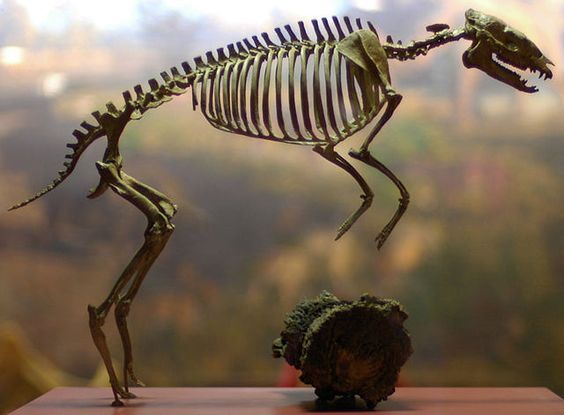
Unicorns walked the Earth more recently than believed
Legends and names referring to a special type of unicorn or mysterious beast with one horn, as opposed to the delicate imaginary unicorns of Europe mostly based on narwhal horns, are scattered across the former range of Elasmotherium from China to Eastern Europe. They have been noted there since the first known literature of the Middle Ages.
Elasmotherium ("Thin Plate Beast"), also known as the Giant Rhinoceros or Giant Siberian Unicorn, is an extinct genus of rhinoceros endemic to Eurasia during the Late Pliocene through the Pleistocene, documented from 2.6 Ma to as late as 29,000 years ago in the Late Pleistocene. Three species are recognised. The best known, E. sibiricum, was the size of a mammoth and is thought to have borne a large, thick horn on its forehead.
Like all rhinoceroses, elasmotheres were herbivorous. Unlike any others, its high-crowned molars were ever-growing. Its legs were longer than those of other rhinos and were adapted for galloping, giving it a horse-like gait.
Various theories of Elasmothere morphology, nutrition and habits have been the cause of wide variation in reconstruction. Some show the beast trotting like a horse with a horn; others hunched over with head to the ground, like a bison, and still others immersed in swamps like a hippopotamus. The use of the horn and whether or not there was one, and how large, have been popular topics. The statistical correlations of modern palaeontology have taken much of the speculation out of the subject, although some details remain undetermined.
Vladimir Onufryevich Kovalevsky first proposed a connection between hypsodonty and grazing for horses in 1873.
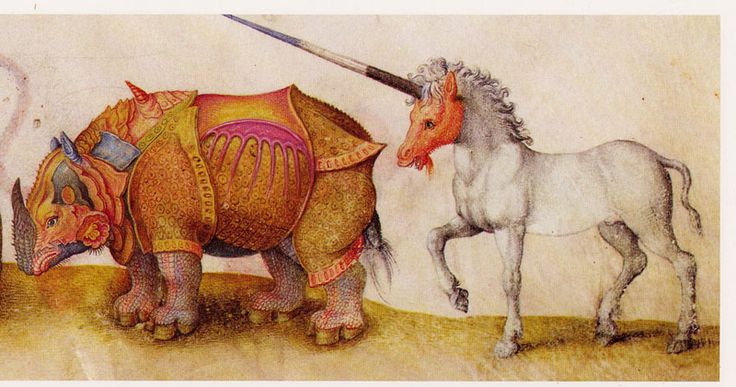
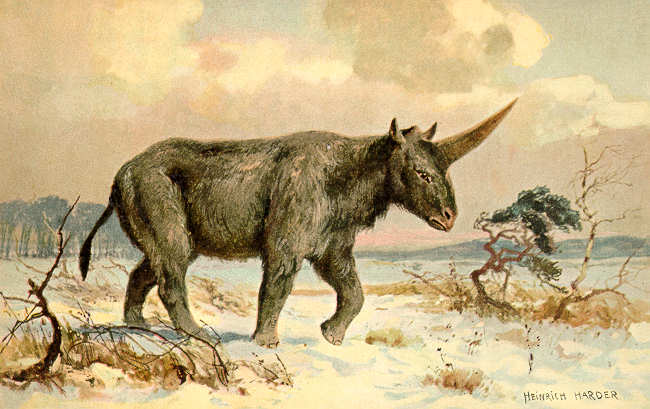
Siberian unicorn – Elasmotherium sibiricum.
According to a study published in the American Journal of Applied Sciences ~ Scientists previously thought the creature with the partially mythical name died out about 350,000 years ago, but a newly discovered fossilized skull reveals it lived here much more recently.
The skull was found in the Pavlodar region of Kazakhstan, and scientists hope it will help shed light on how some members of the species apparently were able to survive as long as they did.
Before you get too excited, though, here's the catch: The Siberian unicorn really looked like more of a rhinoceros than a horse. It reportedly stood about 6 feet 6 inches tall, measured around 15 feet long, and weighed about 8,000 pounds.
As Science Alert explains, "That’s closer to woolly mammoth-sized than horse-sized."
It is interesting to note that Aurochs, ancient bull, were immortalised in prehistoric cave paintings and admired for their brute strength and "elephantine" size by Julius Caesar. The huge cattle with sweeping horns which once roamed the forests of Europe have not been seen for nearly 400 years. The last animal disappeared from the British Isles in the Iron Age and the breed was declared extinct in 1627 after a female died in the forests of Poland.
The Ceratomorpha are so-called because their families, such as the Rhinocerotidae, of which Elasmotherium is indisputably one, are characterised by the presence of hooves, or horns and hooves, made of keratin, the same substance of which hair is made. These keratin structures appear to have formed in the Mesozoic, a remnant in humans being the nails. A keratin horn is to be distinguished from a bone horn and a tusk. Bone forms the base of most horns, but in some cases the horn is entirely of bone. A tusk is a modified canine or incisor tooth. Rhinocerotidae have had tusks, but not Elasmotherium. Two open questions are whether they were horned or hornless, hairy or hairless. Most Rhinocerotidae have and have had horns, but there are some instances of hornlessness, and most are or were hairy, such as the woolly rhinoceros, but no instances of hair or horn have yet been found for Elasmotherium. Only circumstantial evidence of them exists.
The main evidence suggestive of a horn on Elasmotherium is a frontal protuberance, which struck the attention of the late 19th century palaeontologists and was immediately interpreted as the bony basis for a horn by most investigators from that time forward. A skull of E. sibiricum from the Volga region (cast shown in this article's lead picture) described by Alexander Brandt in the Russian journal, Niwa, and reported in Nature in 1878 offers the following description of the protuberance: hemispherical, 5 inches (13 cm) deep, furrowed surface, circumference of 3 feet (0.91 m). The furrows are interpreted as the seats of blood vessels for the tissues that generated the horn:
The whole analogy with the rhinoceros points with the greatest certainty to the previous existence of a horn, which, to judge from the size of the blood vessels once encircling the base, must have possessed enormous dimensions.
If horns are keratinous, they have a bone core. Rhinocerotids horns, however, are uniquely derived. This tissue is "strikingly convergent" with other "cornified epidermis" in horses, cetaceans, artiodactyls and birds. The horn is not attached to the bone of the boss but grows from the surface of a dense dermal tissue.
Brandt was already familiar with the legend of a unicorn among the Tatars of Siberia with a horn so large it required a sledge for transport, and made the connection in interpreting the bump as the base of a horn.
In any case, the non-circular base indicates a section through the horn would not have been circular. This possibility is supported by another fossil with a non-circular partially healed puncture wound in the base, chiefly interpreted as the result of duelling other males with the horn.
Elasmotherium is believed to have descended from the Late Pliocene genus of Central Asia, Sinotherium. Elasmotherium is thought to be the most derived genus of elasmothere, with E. caucasicum in turn being more derived than E. sibiricum.
The evolution of Rhinocerotidae follows a very similar pattern to the evolution of the Equidae, both being facets of the evolution of mammalian herbivores during the Cenozoic. The overall pattern is based on the evolutionary development of grass and grassland, and further the changing distribution of C3 and C4 types of plant metabolism.
In place of the prehistoric C3 grasslands (which are no longer extant) was the savanna, today's subtropical mixture of grasses and sedges. The deciding factors in this turn of evolution were a documented increase in temperature and aridity over the period. Faced with scant nutrition from browsing, the smaller Rhinocerotidae and Equidae declined in diversity, the gate in that direction, so to speak, now being closed.
The evolutionary response in the Pliocene was in the direction of bulk-feeding. Massive grazers, such as Elasmotherium, maximally hypsodont, moved across vast ranges consuming C4 grass in bulk. While the horses and other more nearly modern grazers could rely on galloping for mobility in any circumstance, there is a question as to what degree the brachypodial giants can be said to be "cursorial". Elephants, for example, must keep one foot on the ground, where true gallopers are entirely off it for brief intervals. The horns and impenetrable body armour insured that the giants would not be required to gallop away from any predator. At least until the arrival of man, they were, as the legends relate, lords of the savanna.
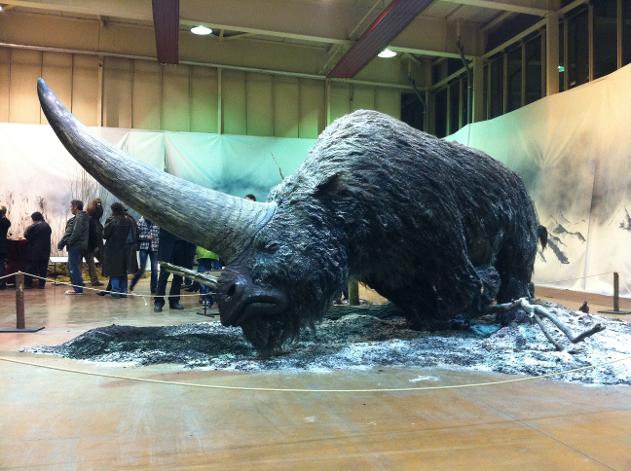
The main evidence suggestive of a horn on Elasmotherium is a frontal protuberance, which struck the attention of the late 19th century palaeontologists and was immediately interpreted as the bony basis for a horn by most investigators from that time forward. A skull of E. sibiricum from the Volga region (cast shown in this article's lead picture) described by Alexander Brandt in the Russian journal, Niwa, and reported in Nature in 1878 offers the following description of the protuberance: hemispherical, 5 inches (13 cm) deep, furrowed surface, circumference of 3 feet (0.91 m). The furrows are interpreted as the seats of blood vessels for the tissues that generated the horn:
The whole analogy with the rhinoceros points with the greatest certainty to the previous existence of a horn, which, to judge from the size of the blood vessels once encircling the base, must have possessed enormous dimensions.
If horns are keratinous, they have a bone core. Rhinocerotids horns, however, are uniquely derived. This tissue is "strikingly convergent" with other "cornified epidermis" in horses, cetaceans, artiodactyls and birds. The horn is not attached to the bone of the boss but grows from the surface of a dense dermal tissue.
Brandt was already familiar with the legend of a unicorn among the Tatars of Siberia with a horn so large it required a sledge for transport, and made the connection in interpreting the bump as the base of a horn.
In any case, the non-circular base indicates a section through the horn would not have been circular. This possibility is supported by another fossil with a non-circular partially healed puncture wound in the base, chiefly interpreted as the result of duelling other males with the horn.
Elasmotherium is believed to have descended from the Late Pliocene genus of Central Asia, Sinotherium. Elasmotherium is thought to be the most derived genus of elasmothere, with E. caucasicum in turn being more derived than E. sibiricum.
The evolution of Rhinocerotidae follows a very similar pattern to the evolution of the Equidae, both being facets of the evolution of mammalian herbivores during the Cenozoic. The overall pattern is based on the evolutionary development of grass and grassland, and further the changing distribution of C3 and C4 types of plant metabolism.
In place of the prehistoric C3 grasslands (which are no longer extant) was the savanna, today's subtropical mixture of grasses and sedges. The deciding factors in this turn of evolution were a documented increase in temperature and aridity over the period. Faced with scant nutrition from browsing, the smaller Rhinocerotidae and Equidae declined in diversity, the gate in that direction, so to speak, now being closed.
The evolutionary response in the Pliocene was in the direction of bulk-feeding. Massive grazers, such as Elasmotherium, maximally hypsodont, moved across vast ranges consuming C4 grass in bulk. While the horses and other more nearly modern grazers could rely on galloping for mobility in any circumstance, there is a question as to what degree the brachypodial giants can be said to be "cursorial". Elephants, for example, must keep one foot on the ground, where true gallopers are entirely off it for brief intervals. The horns and impenetrable body armour insured that the giants would not be required to gallop away from any predator. At least until the arrival of man, they were, as the legends relate, lords of the savanna.
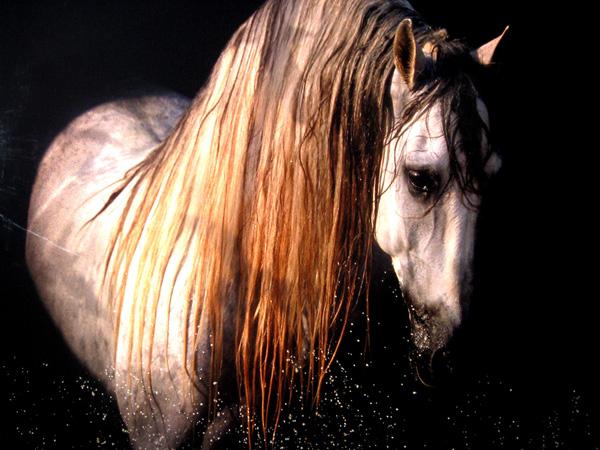
The Horse
The evolution of the horse, a mammal of the family Equidae, occurred over a geologic time scale of 50 million years, transforming the small, dog-sized, forest-dwelling Eohippus into the modern horse. Paleozoologists have been able to piece together a more complete outline of the evolutionary lineage of the modern horse than of any other animal.
The horse belongs to the order Perissodactyla (odd-toed ungulates), the members of which all share hooved feet and an odd number of toes on each foot, as well as mobile upper lips and a similar tooth structure. This means that horses share a common ancestry with tapirs and rhinoceroses.
The perissodactyls arose in the late Paleocene, less than 10 million years after the Cretaceous–Paleogene extinction event. This group of animals appears to have been originally specialized for life in tropical forests, but whereas tapirs and, to some extent, rhinoceroses, retained their jungle specializations, modern horses are adapted to life on drier land, in the much harsher climatic conditions of the steppes.
The early ancestors of the modern horse walked on several spread-out toes, an accommodation to life spent walking on the soft, moist grounds of primeval forests. As grass species began to appear and flourish, the equids' diets shifted from foliage to grasses, leading to larger and more durable teeth. At the same time, as the steppes began to appear, the horse's predecessors needed to be capable of greater speeds to outrun predators. This was attained through the lengthening of limbs and the lifting of some toes from the ground in such a way that the weight of the body was gradually placed on one of the longest toes, the third.
Wild horses were known since prehistory from central Asia to Europe, with domestic horses and other equids being distributed more widely in the Old World, but no horses or equids of any type were found in the New World when European explorers reached the Americas. When the Spanish colonists brought domestic horses from Europe, beginning in 1493, escaped horses quickly established large feral herds.
The genus Equus, which includes all extant equines, is believed to have evolved from Dinohippus, via the intermediate form Plesippus. One of the oldest species is Equus simplicidens, The Hagerman horse, described as zebra-like with a donkey-shaped head. The oldest fossil to date is ~3.5 million years old from Idaho, USA. The genus appears to have spread quickly into the Old World, with the similarly aged Equus livenzovensis documented from western Europe and Russia.
The Chinese k'i-lin, referring to some sort of beast, was loaned in various forms into the Turkic and Mongolic languages and lore. The writers of works in those languages have not known how to depict these strange beasts. A common theme is that they have a single horn, are dark and are huge.
The Chinese wrote of other unicorns, such as the Xiezhi, but it was less like a real animal and more a symbolic figure. It had the ability to discriminate right from wrong and therefore a representation of it was placed in the courtrooms of the Han dynasty and, in the 3rd and 4th centuries, on the caps of judges. It looks like a seated or standing lion with a horn rising from the top of the head. In contrast to this mythical beast, the k'i-lin is presented as an animal actually caught by hunting parties of the past.
The Shiji ("Historical Records") of Sima Qian in the 2nd century mentions the capture of a "deer-like" animal with one horn in 122 BC. The Chunqin, an encyclopaedia of the 3rd century BC, states that a unicorn was captured in 481 BC, but without any description. Chinese representations of unicorns vary quite a lot, but an engraving on a bronze vessel of the Warring States period shows an animal very like the cave paintings supposed to be of Elasmotherium: head down for grazing, horn protruding horizontally from the forehead, neck and shoulders humped.
In the northeast of the range, in 1866 Vasily Radlov reported a legend among the Yakuts of Siberia of a "huge black bull" killed by spear, which had "a single horn" so large that it required a sledge for transportation. In 1878, A. F. Brandt suggested the beast was an Elasmotherium. In 1921, Gavril Ksenofontov collected some Sakha legends about huge, one horned bulls, usually with pale blue or dun, long, wool-like fur. The big bull with a single, long horn is also mentioned in the yakut epic Olonkho. This bull, which is known as the 'Bull of Winter', had pale blue fur and symbolises winter and frost.
From medieval northern Russia, probably Veliky Novgorod, a collection of ballads has survived, combined into a spiritual theme deriving ultimately from Zoroastrianism, but with Christian overtones, called the Stikh o Golubinoi knige, or in another version the Golubinaia kniga, "The Book of the Dove".[66] The "dove", or golub of the Christian work is probably an alteration of glub, "depth", so that the reconstructed name, *Glubinnaia kniga, is on the same theme as the Zend Avesta and similar works in Iran, the struggle between cosmic good and evil.
The force of pravda, or "rightness", is symbolised by a beast called mainly the Indrik, but also Indra, Beloiandrikh, Kondryk, Edinrog and Edinor. The name is a calque: Greek mono-keros ("single-horn") > ino-rog (in, "one"; rogom, "horn") > edinrog > Indrik. As a unicorn struggling with a lion representing krivda, "lies", the Indrik has the body of a goat or a horse in representations.
An Indrik composite from all the variants of the ballads depicts the Indrik as dwelling in the Holy Mountain, which it consumes for sustenance. It is the mother or the father of all animals. It wanders unseen on the plain by day. When other beasts encounter, it they must do obeisance. The Indrik saves the world from drought by digging springs of pure water. By night, it wanders in the subterranean world, forging a path with its horn. There it purifies all the waters and releases them from any blockages. (Water-conning as mentioned in many ancient myths of the unicorn).
The righteous but fantastic unicorn also appears in the Bundahišn or Zand Āgāhīh, a Middle Persian Zoroastrian composition concerning the "deep and miraculous utterances" about the creation, the archetype of the *Gubinnaia kniga, "Book of the Deep". Its unicorn is an ass of 3 feet, 6 eyes, 9 mouths, 2 ears, 1 horn, a dark blue head and a white body, which is a symbolic rather than a real entity. It stands in the sea of Fraxwkand (wherever that is) and purifies the waters.
In fact the Arabo-Persian word for unicorn in the region was karkadann, which extended also to India, and was loaned into the Turkmen language as kergeden and the Ottoman Turkish language as gergeden, among others. The word had an equivocal meaning: unicorn and rhinoceros.
Science writer and cryptozoologist Willy Ley theorised that these legends have simply been passed down since a hunting association with the beast in prehistoric times, and that the animals did not actually survive into recorded history. One argument for survival is the testimony by the medieval traveller, Ibn Fadlan. His account states:
Near this river (the Volga) is a vast wilderness wherein they say is an animal that is less than a camel and more like a bull in size. Its head is like the head of a camel, and its tail is like the tail of a bull, while its body is like the body of a mule, and its hooves are like the cloven hooves of a bull. In the center of its head, it has a thick round horn, which as it rises from the head of the animal gets to be thinner until it becomes like the point of a lance. The length of some of these horns is from three to five cubits, and there are those that may attain to a greater or lesser length. The animal grazes on the leaves of trees, which are quite green. When it sees a horseman, it makes straight for him, and if he happens to have under him a fast horse, he is rendered safe from it with some effort. If it overtakes him, it removes him from the back of his horse with its horn, hurls him into the air, and then catches him with its horn. It continues in this manner until it kills him. It does not bother the horse in any form or manner. They seek out this animal in the forests in order to kill it. They do that by climbing the tall trees among which it is found, and with this object in mind, they assemble a number of archers with poisoned arrows. When it stands in their midst, they shoot at it until it is severely wounded and killed by them.
The Karkadann
The Karkadann (from Kargadan, Persian: "Lord of the Desert") was a mythical creature said to live on the grassy plains of India and Persia.
The word kargadan also means rhinoceros in Persian and Arabic.
Depictions of karkadann are found also in North Indian art. Like the unicorn, it can be subdued by virgins and acts ferociously toward other animals. Originally based on the Indian Rhinoceros (one of the meanings of the word) and first described in the 10th/11th century, it evolved in the works of later writers to a mythical animal "with a shadowy rhinocerine ancestor" endowed with strange qualities, such as a horn endowed with medicinal qualities.
The future confusion between the rhinoceros and the unicorn was already in the making since the Persian language uses the same word, karkadann, for the mythological animal as it does for the rhinoceros, and this confusion is evident also in the illustrations of the creature.
The Persian physician Zakariya al-Qazwini (Al-Qazwini, d. 1283) is one of the writers who at the end of the thirteenth century links the karkadann's horn with poison. Later authors have the horn perspire when poison is present, suggesting the horn is an antidote and connecting it to alicorn, though this connection is not made by all writers. The karkadann is referred to by Elmer Suhr as the "Persian version of the unicorn". The name appears also in medieval European bestiaries, such as those from Escorial and Paris, where the name karkadann appears in the captions of unicorn illustrations.
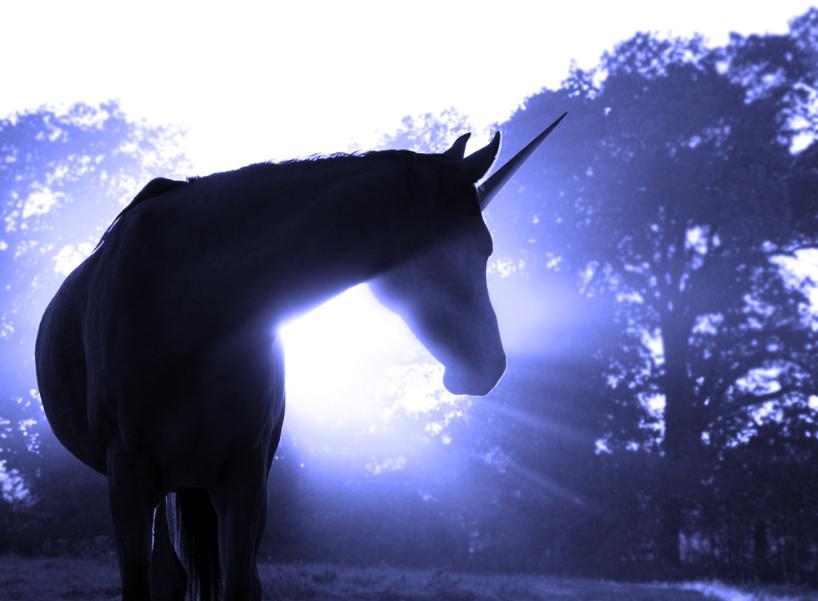
The Qilin
The Qilin (Chinese) is a mythical hooved chimerical creature known in Chinese and other East Asian cultures, said to appear with the imminent arrival or passing of a sage or illustrious ruler. It is a good omen thought to occasion prosperity or serenity. It is often depicted with what looks like fire all over its body.
Qilin is often translated into English as "unicorn" as it can sometimes be depicted as having a single horn, although this is misleading as qilin may also be depicted as having two horns. A separate word (pinyin: Dújiǎoshòu) is used in Chinese for "unicorns". A number of different Chinese mythical creatures can be depicted with a single horn, and a qilin, even if depicted with one horn, would be called a "one-horned qilin" in Chinese, not a "unicorn".
It is because of the whimsical, supernatural, mythical, mystical, and religious similarities in antiquity to the Western unicorns that the Chinese government minted coins in silver and gold several times depicting both the qilin and the Western Unicorn together.
Research Links
https://en.wikipedia.org/wiki/Elasmotherium
https://en.wikipedia.org/wiki/Karkadann
https://en.wikipedia.org/wiki/Qilin
https://en.wikipedia.org/wiki/Evolution_of_the_horse
https://en.wikipedia.org/wiki/Hagerman_horse